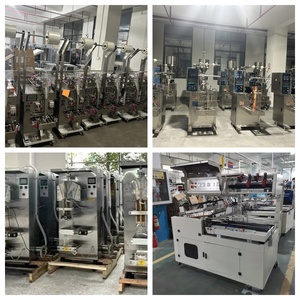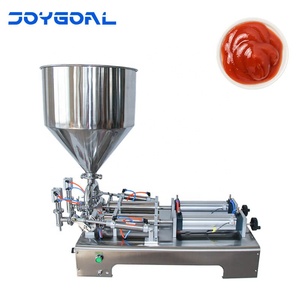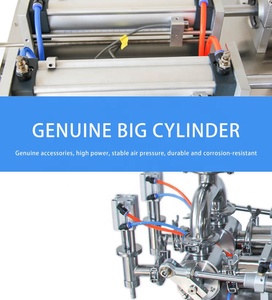
All categories
Featured selections
Trade Assurance
Buyer Central
Help Center
Get the app
Become a supplier

(1688 products available)





















These machines are suitable for diverse liquid, paste, and adhesive forms.
Adhesive Dispensing Machines
Automated adhesive dispensers apply adhesive uniformly, improving connection quality and decreasing waste. They're often used in furniture development, automotive production, and electronics, where precision application and reduction of manual tasks are required.
Putty Dispenser
This dispenser is used in the construction of buildings and automobile repair works. Often, they are used in sealing joints, filling cracks, and smoothing surfaces. This helps to ensure durability and weather resistance in the buildings or in the automobiles' body parts.
Past Dispensing Machines
Paste dispensing machines work with a variety of high-viscosity liquids, including food pastes like peanut butter, toothpaste, and chemical pastes used in industrial processes. These machines ensure accurate dosage and increase consistency in production, which is largely important in the food processing and personal care industries.
Syringe Dispensing Machines
Syringe dispensing machines are capable of shooting precise volumes of high-viscosity fluids through syringe barrels, and doable dispensers are great for small quantities. Great dispensers are also useful in medical and cosmetic fields where accuracy and hygiene are very important.
Cosmetic Industry
Cosmetics with varying viscosity, including creams, gels, and ointments, are dispensed through high-adhesion viscoelasticity machinery. Here, the exact quantity and smooth finishing texture assured by a machine enhance the product's feel and effectiveness. In this realm, the machine's time-saving property becomes important, especially when large work needs to be done. Dispensing machines also have aesthetic functions: they keep the colors of the products unchanged by preventing air intrusion, which can lead to oxidation and thus discoloration of the products.
Food Industry
In food processing, paste substances such as peanut butter, sauces, and jams are handled with great care by adhesive machines. The uniformity of food texture and flavor goes a long way in ensuring its safety through tight control of the dispensing process. In order to meet consumer demands, the industry strives to offer products with a uniform texture and taste. Dispensing systems reduce the time of production and minimize the number of wastes encountered when using manual dispensing.
Pharmaceutical Industry
Dispensing machines are of great importance in the Pharmaceutical industry; drugs like ointments, gels, and liquid medicines with high viscosity need to be classified and dispensed through strict handling and measurement. Syringe dispensers, for example, are widely employed in this field because they make it easy to handle small volumes of medication while maintaining sterility. This increased accuracy not only complies with legal requirements but also makes it easier for patients to use medication correctly.
Construction Industry
High-viscosity sealants, adhesives, and lubricants are predominantly used in construction dispensing machines. These machines are usually made to ensure that construction materials work together in unity, providing the structures with good bonding, sealing, and durability. A paste dispenser regulates the amount of used material, which minimizes wastage and helps improve project efficiency.
Electronics Industry
Electronic assemblies typically require the use of adhesives and sealants with a high coefficient of viscosity, which can be dispensed with ease using these machines. Precision and consistency of the machines aid in the protection of the circuitry and enhancement of the assembled products.
These machines are often automated and controlled through computers, which offer great accuracy in dispensing even the thickest liquids. This technology is greatly advantageous and finds major uses in many industries.
Nozzle Sizes
Nozzle sizes vary depending on application requirements. Smaller nozzles allow for higher precision applications, while larger ones accommodate greater viscosity. Different nozzle sizes are normally interchangeable, which increases versatility.
Dispensing Pressure
Pressure rates are adjustable, which generally helps change according to fluid nature and application purpose. Fluids of lower viscosity are often dispensed at lower pressures, whereas those of higher viscosity need extra pressure. This flexibility is suitable for a wide range of adhesives.
Control System
Advanced dispensing machines carry out their functions through computerized systems that allow great precision to be achieved in the cells. These controls can be given touch screens, and PCs can be programmed to give the needed directions in minute detailing. Thus, parameters such as flow rate, stroke length, and time can be altered to meet the particular requirements of the task at hand.
Material Composition
Dispensing machines, and especially those that work with high-viscosity liquids, collaborate and coordinate together with diverse metals, mostly steel, and other metals coated with non-stick substances for better performance. These materials are generally chosen for their resilience against chemical exposure and wear and tear, giving the machines a longer life span even when used under tough working conditions.
Automation Level
There are fully automated machines that require little or no human hands and can operate continuously with efficiency. In the case of semi-automatic machines, the human operator's work is minimized but still requires some input. This level of automation is appropriate for most production needs: high-volume production requires full automation, while low-volume production may require semi-automation.
Site Preparation
The area in which the dispensing system will be installed should have adequate electrical supply, computer interfaces, and air compressing power (if hydraulic pressure is utilized). The workstation must be arranged in a manner that is clean and clutter-free to promote effective and efficient working conditions.
Assembly Components
The various equipment used in hydraulic machines include the main body, nozzles, and mechanical components that need to be fixed together. According to the manufacturer's instructions, the parts should then be brought together. For machines with extra attachments, such as mixers or heaters, these should be fitted as per the guidelines and manufacturers provide.
Electrical Connections
The machine's electrical wires should be linked while ensuring that power supply requirements are met. The machine dispenses often computerized; thus, it has to be linked to a PC or external control device to input and manage the procedures.
Testing and Calibration
After installation, tests and calibrations should be done to guarantee that the machine is ready for work. Modifications should be made in the dispensing rates, pressure, and other related parameters, and tests should be done using a fluid similar to the actual fluid to check readiness.
Staff Training
Working with advanced dispensing machines calls for sufficient training of the workers. The machine's operations, computerized input, and safety policies must be well understood by the operators before production starts.
Maintenance Tips
The regular maintenance that should be done on the dispensing gadget includes the cleaning and flushing of the dispensing lines after every usage. This reduces the old artifact and, more importantly, prevents the clogs that may occur during storage. An inspection program should be set up to check for worn or damaged parts, especially seals and nozzles, to ensure dispensing efficiency.
Common Issues and Fixes
"Common issues" include low flow rates, clogs in nozzles, and variation in dispensing pressure. Aged materials, such as clogs in nozzles, require frequent cleaning or replacement; worn-out seals require replacement, and machinery is likely to be interrupted. Low air pressure or faultiness in the pump could result in low flow rate, and this should be solved by checking the air pressure or by working on the pump (if necessary). Regular checks and pre-emptive actions can help a lot in the reduction of machine mishaps.
Quality Control Measures
To dispel any inconsistencies in the application of fluids, businesses should place great demand on the quality of equipment and ensure regular maintenance and calibration of the equipment. Provision of training to workers on how to operate the machine will greatly minimize human error. In addition, real-time monitoring and recording of dispensing activities help facilitate prompt detection of anomalies.
Safety Precautions
Handling High-Viscosity Fluids Safely
Many fluids have great resistance to flow and, as such, may require higher energy input to handle. Some of these fluids can be very sticky or gelatinous in texture when classified as high viscosity, which can cause it to cling to a surface or ooze very slowly if not effectively cleaned. Training employees to manage spillage, use correct containment procedures, and ensure that all high-viscosity fluids are handled in the right fashion eliminates accidents and lowers the chances of product contamination.
Emergency Procedures
A1: Dispensing machines ensure precision application, which reduces waste and improves the strength and durability of the bonds formed.
A2: These dispensers are widely used in construction, manufacturing, automotive repairs, and any industry where the adhesive's thickness needs to be handled with ease.
A3: The higher the viscous fluid, the more complex systems will be required to generate the proper fluid movement.
A4: The increase in temperature decreases the viscosity of the adhesive, thereby improving its flow capability.
A5: The maintenance of such equipment will be eased if the Dispensing System Material is compatible with the Adhesive Component.